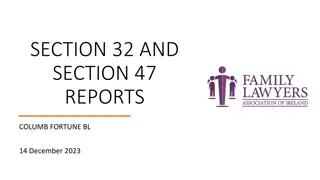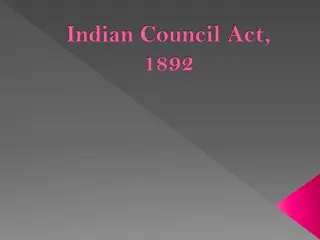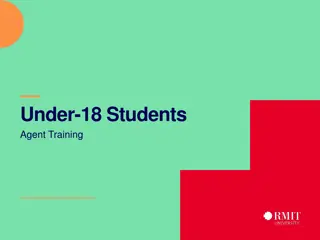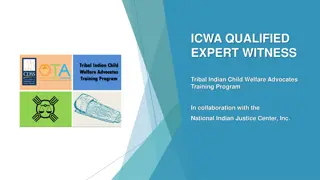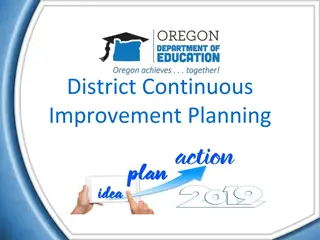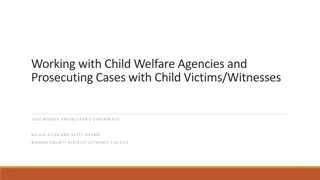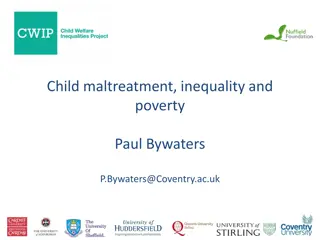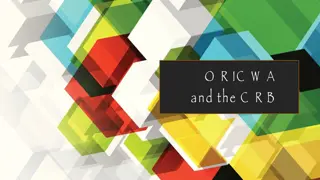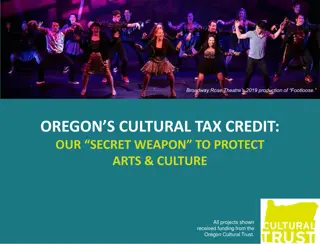Oregon Indian Child Welfare Act (ORICWA) Explained - Expert Q&A
The Oregon Indian Child Welfare Act (ORICWA) enhances protections for Indian families by embedding federal law into state law and providing additional guidance to Oregon courts. This comprehensive guide covers the application of ORICWA, involvement of various parties, and criteria for determining Indian child status. Explore key aspects such as dependency, voluntary foster care, guardianship, and more under ORICWA/ICWA. Learn about the definition of an Indian child and access resources for federally recognized tribes. Discover the significance of ORICWA in ensuring the rights of Indian parents and custodians.
Download Presentation

Please find below an Image/Link to download the presentation.
The content on the website is provided AS IS for your information and personal use only. It may not be sold, licensed, or shared on other websites without obtaining consent from the author. Download presentation by click this link. If you encounter any issues during the download, it is possible that the publisher has removed the file from their server.
E N D
Presentation Transcript
OREGON ICWA Q AND A: ASK THE EXPERTS, PART 1 Hon. Morgan Long Adrian (Addie) Smith Lea Ann Easton Kristy Barrett Shannon Dennison March 5, 2021
INTRODUCTION Pursuant to 25 USC 1921, states may provide more protection to Indian families, and that is what the Oregon Indian Child Welfare Act (ORICWA) sets out to do. ORICWA enhances and clarifies the federal law by embedding it into state law and providing additional guidance to Oregon courts making decisions about Indian children and their families. While ORICWA provides greater protections, there are few significant changes to the federal law. When in question, both ICWA and its regulations state that in any case where state or federal law provides a higher standard of protection to the rights of the parent or Indian custodian, the Court shall apply the higher standard. 25 USC 1921.
Federal Indian Child Welfare Act: 25 U.S.C. 1901 to 1923 Federal Regulations: 25 CFR 23 Oregon Indian Child Welfare Act: APPLICABLE LAW Or Laws 2020, ch 14 (1stSpec Sess) Case law Federal Guidelines: Guidelines for Implementing the Indian Child Welfare Act (December, 2016)
PRELIMINARY QUESTIONS When does ORICWA apply? Who is involved? Inquiry Reason to know
Dependency, Voluntary Foster Care Placement and Relinquishment, Guardianship (419B), Termination of Parental Rights, Adoption, Delinquency (sometimes status offense) WHEN DOES ORICWA/ICWA APPLY? AND There is reason to know child is an Indian child (or child is an Indian child)
Any unmarried person who has not attained 18 years of age, and is a: Member or citizen of an Indian tribe, or Is eligible for membership or citizenship and is the biological child of a member of an Indian tribe. INDIAN CHILD DEFINED (Section 2(4)) Indian tribe must be federally recognized. Section 2(6) List of federally recognized tribes: https://www.federalregister.gov/documents/2019/02/01/2019-00897/indian- entities-recognized-by-and-eligible-to-receive-services-from-the-united- states-bureau-of Designated tribal agents for service of notice: https://www.federalregister.gov/documents/2020/04/30/2020-09155/indian- child-welfare-act-designated-tribal-agents-for-service-of-notice
In addition to the methods for establishing parentage under ORS 109.065, a man s parentage of an Indian child is acknowledged or established for purposes ORICWA & ORS chapter 419B if the man s parentage has been: (1) Established under tribal law; (2) Recognized in accordance with tribal custom; or PARENTAGE (3) Openly proclaimed by the man to the court, to the Indian child s family, to the Department of Human Services or to an Oregon licensed adoption agency. Openly proclaimed & 2021 legislative fixes (Section 4)
Defined: An Indian, other than the child s parent, who has custody of the Indian child, or to whom temporary physical care, custody and control has been transferred by the Indian child s parent. (Section 2(6)) INDIAN CUSTODIAN Is a legal party. (Section 28(H)) Is entitled to court appointed counsel. (Section 20(1)(b))
Custody: An individual has custody of an Indian child if the person has physical or legal custody of the Indian child under any applicable tribal law, tribal custom or state law. CUSTODY OF AN INDIAN CHILD Continued custody: An Indian child s parent has continued custody of the Indian child if the parent has, or previously had, custody of the Indian child. (Section 3)
INQUIRY ODHS: Person taking child into protective custody, or as otherwise required under ORS chapter 419B, must make a good faith effort to determine whether there is reason to know that a child is an Indian child. Includes consultation with child, child s parents, person having custody or residing with child, extended family and any other person expected to have knowledge Must contact tribe which the child is or may be a member of to determine child s affiliation. Section 15(1)(emergency inquiry requirements); 15(2) (non-emergency inquiry requirements) Courts must ask, on the record, each individual present, whether there is reason to know that the child is an Indian child at the commencement of each designated hearing. Section 15(3)
A court has reason to know if: Person present, the child, officer of the court, Indian tribe, organization or agency informs the court the child is an Indian child, or that information has been discovered that the child is an Indian child. Child s domicile or residence, or child s parent or Indian custodian is on a reservation or in an Alaska Native village; REASON TO KNOW Child or parent possesses an ID card or other record indicating membership; Testimony, documents or any other indicia that indicates the child is an Indian child. If there is reason to know : Treat as and ICWA case until the court on the record determines the child does not meet the definition Section 15(4) and (5)
If neither parent is an enrolled member of a tribe, under what circumstances, if any, could the court still have reason to know that the child is an Indian child? REASON TO KNOW Other practical advice/examples?
If there is reason to know a child is an Indian child, the tribe is a party under ORS 419B.875 (Section 28) TRIBE IS A PARTY How courts can work with the tribe and eliminate barriers to participation.
Tribe that is a party under ORS 419B.875(1)(a)(H) may be represented by any individual, regardless of whether the individual is licensed to practice law. (no unlawful practice of law for tribal case worker) (Shuey; Section 19(1)) TRIBAL Codified recent rule change allowing for out-of-state tribal counsel or a parent s attorney to appear w/o associating with local counsel/paying REPRESENTATION (Section 19(2))
Is the child a ward of tribal court? OR Is the child domiciled on tribal land? If no: State Jurisdiction If yes: Is the court/land a tribe that has concurrent jurisdiction under PL 280? If no: Tribal Jurisdiction. (tribal and state judges should work together like under UCCJEA to get the case into tribal court) WHO HAS JURISDICTION? If yes: Is there a tribal state agreement making tribal jurisdiction the default? If no: concurrent jurisdiction If yes: Tribal jurisdiction (tribal and state judges should work together like under UCCJEA to get the case into tribal court) (Section 12)
KEY PROTECTIONS Notice Active Efforts Best Interests Qualified Expert Witness Placement Preferences Higher Standard of Proof
The party providing notice must: Promptly send notice of the child custody proceeding by registered or certified mail, with return receipt requested to Each tribe of which the child may be a member or eligible for membership; The child s parents and/or the child s Indian custodian Appropriate BIA Regional Director NOTICE File an original or a copy of each notice sent with the court, together with any return receipts or other proof of service. No hearing requiring notice may be held until at least 10 days after the last individual receives the required notice. Upon request, the court shall grant the Indian child s parent, Indian custodian or tribe up to 20 additional days. (Section 16)
Prevent break up OR reunite Affirmative, active, thorough, timely Higher than reasonable; tailored to the facts of the case; documented in detail in writing on the record; include assisting a parent through the steps of a case plan and accessing or developing the resources necessary to do so; must be conducted in partnership ACTIVE EFFORTS Must be documented in detail in writing and on the record. (Section 18)
In addition to the examples from ICWAs 2016 Regulations: -Providing post-reunification services and monitoring for the duration of juvenile court s jurisdiction -Considering alternative options to address the needs of the Indian child s parents, Indian custodian or extended family members. Monitoring progress and participation in the services. -Any other efforts that are appropriate to the Indian child s circumstances. -Taking steps to keep the Indian child and the Indian child s siblings together whenever possible. -Supporting regular visits with the Indian child s parent or Indian custodian in the most natural setting possible, as well as trial home visits during any period of removal, consistent with the need to ensure the health, safety and welfare of the Indian child. ACTIVE EFFORTS -Identifying community resources, including housing, financial assistance, employment training, transportation, mental health, health care, substance abuse prevention and treatment, parent training, transportation and peer support services and actively assisting the Indian child s parents or, when appropriate, the Indian child s extended family members, in utilizing and accessing those resources; -Conducting or causing to be conducted a diligent search for the Indian child s extended family members, contacting and consulting with the Indian child s extended family members and adult relatives to provide family structure and support for the Indian child and the Indian child s parents
When making a best interest determination, the court shall, in consultation with the tribe, consider the following: Protection of the safety, well-being, development and stability of the Indian child; Prevention of unnecessary out-of-home placement of the Indian child; Prioritization of placement of the Indian child in accordance with the placement preferences; BEST INTERESTS Value of establishing/maintaining relationship with tribe and tribal community; and Importance to the child of the tribe s ability to maintain the tribe s existence and integrity in promotion of the stability and security of Indian children and families. (Section 5)
Petitioner must provide at least one qualified expert witness who is to testify to: Whether continued custody is likely to result in serious emotional or physical damage to the child The prevailing social/cultural standards and child rearing practices of the tribe Who is a QEW? (order of priority) Designated by tribe (with documented efforts) QUALIFIED EXPERT WITNESS Member of tribe/identified by tribe as knowledgeable about child rearing Person with substantial experiences delivering services to Indian families and knowledge of the child s tribe Person with substantial experiences delivering services to Indian families and knowledge of a culturally similar tribe DHS caseworker cannot be the QEW Petitioner must file a declaration with the court describing efforts to identify a QEW. (Section 17)
An Indian child must be placed in the least restrictive setting that: Most closely approximates a family, taking into consideration sibling attachment; PLACEMENT PREFERENCES Allows the Indian child s special needs, if any, to be met; Is in reasonable proximity to the Indian child s home, extended family or siblings; and Is in accordance with the order of preference established by the Indian child s tribe (if any). Section 23(1)
PLACEMENT PREFERENCES (WHEN NO TRIBAL DESIGNATION) Process to place outside the preferences Motion for good cause; if objection hearing must occur Good cause: Substitute Care Extended family Foster home approved by tribe Foster home with an Indian parent Institution suitable for Indian child s needs Child s preference Sibling attachment Extraordinary needs Proof of diligent search Good cause may be informed by parent s preference Good cause may not be: Socioeconomic conditions of tribe/perception of justice system or social service system Guardianship and Adoption Extended family Tribal member family Indian Family Distance Ordinary bonding Court s determination must be in writing What if there hasn t been a good cause finding and the child is placed outside of the preferences? (Section 23/ 25 U.S.C. 1915) (Section 23)
has the meaning given that term by the law or custom of an Indian child s tribe. If the meaning of extended family member cannot be determined by law or custom of the tribe, extended family member means a person who has attained 18 years of age & who is the child s grandparent, aunt, uncle, brother, sister, sister-in- law, brother-in-law, niece, nephew, first cousin, second cousin, stepparent or, as determined by the Indian child s tribe, clan or band member. EXTENDED FAMILY MEMBER (Section 2)
Start early Where does tribe want the child to be placed? CONCURRENT PLANNING Children placed outside of preferences Preserving/maintaining relationships Cultural agreements start early Where does tribe want the CHILD TO BE PLACED? CHILDREN PLACED OUTSIDE OF PRESERVING/MAINTAINING RELATIONSHIPS CULTURAL AGREEMENTS
QUESTION Does ODHS need to continue to make efforts to search for another permanent placement that complies with a higher level of placement preferences throughout the case, particularly if the child is already in a type of home that would meet one of the levels of placement preference?





